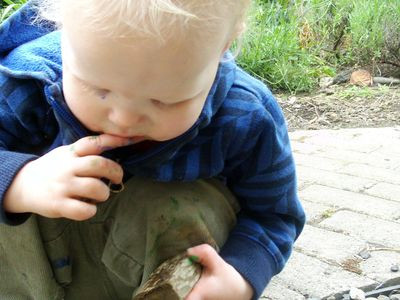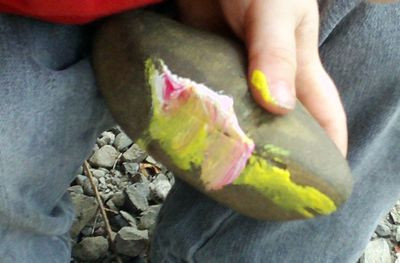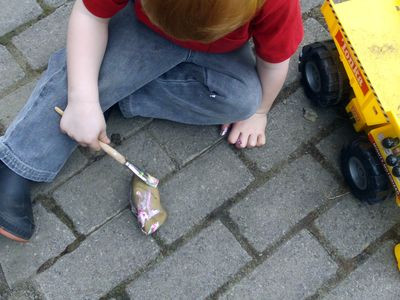Can You Paint Rocks With Washable Paint? Yes, you can definitely paint rocks with washable paint! At rockscapes.net, we believe that painting rocks with washable paint is a fantastic way to unleash creativity and add a personal touch to your landscape, offering a temporary splash of color and artistic expression that’s perfect for both kids and adults, allowing for endless experimentation and easy clean-up. Exploring rock painting ideas and different painting techniques, particularly using landscape rocks as your canvas, opens up a world of possibilities.
1. What Makes Painting Rocks a Great Activity?
Painting rocks is a wonderful activity that combines art and nature, providing a unique canvas for creative expression. It’s an engaging way to connect with the outdoors and transform ordinary stones into personalized works of art.
Why is rock painting so popular?
Rock painting has become increasingly popular for several reasons:
- Creativity: It allows you to express your creativity and imagination in a unique way.
- Accessibility: It’s an accessible and affordable activity for people of all ages and skill levels.
- Community: Rock painting often involves sharing and hiding painted rocks, creating a sense of community and connection.
- Stress Relief: The act of painting can be therapeutic and relaxing, providing a welcome break from the stresses of daily life.
What are the benefits of using washable paint for rock painting?
Using washable paint for rock painting offers several advantages, especially when kids are involved:
- Easy Clean-Up: Washable paint can be easily cleaned up with water, making it perfect for young children and messy artists.
- Temporary Art: If you’re not ready to commit to a permanent design, washable paint allows you to change your mind and start over.
- Experimentation: Washable paint encourages experimentation and allows you to try out different colors and techniques without worrying about making mistakes.
Is rock painting suitable for all ages?
Yes, rock painting is an activity that can be enjoyed by people of all ages. Young children can explore colors and shapes, while older children and adults can create more intricate designs. It’s a fun and engaging activity that can be tailored to suit different skill levels and interests.
 Assortment of colorful painted rocks
Assortment of colorful painted rocks
2. Choosing the Right Rocks for Painting
Selecting the right rocks is crucial for a successful painting project. Different types of rocks offer different textures and shapes, which can impact the final result.
What types of rocks are best for painting?
Smooth, flat rocks are generally the best for painting, as they provide a good surface for applying paint. River rocks, beach pebbles, and landscaping stones are all excellent choices. According to Arizona State University’s School of Earth and Space Exploration, sedimentary rocks like sandstone and limestone are porous and may require a base coat before painting.
Where can I find rocks for painting?
You can find rocks for painting in various places:
- Your Backyard: Check your own backyard or garden for suitable rocks.
- Nature Trails: Collect rocks from nature trails or parks, but be sure to follow any local regulations regarding rock collecting.
- Beaches and Rivers: Beaches and rivers are great places to find smooth, flat rocks.
- Craft Stores: Craft stores often sell bags of river rocks or landscaping stones specifically for painting.
- Rockscapes.net: Rockscapes.net offers a wide selection of landscaping rocks suitable for painting projects.
How do I prepare rocks for painting?
Before you start painting, it’s important to clean the rocks to remove any dirt, debris, or loose particles. Wash the rocks with soap and water, and then let them dry completely. This will help the paint adhere better and ensure a smooth, even finish.
3. Selecting Washable Paints and Other Supplies
Choosing the right washable paints and supplies is essential for a fun and successful rock painting experience.
What are the best washable paints for rock painting?
When selecting washable paints for rock painting, look for non-toxic, water-based acrylic paints that are specifically labeled as washable. These paints are designed to be easily cleaned up with water and are safe for children to use.
What other supplies do I need for rock painting?
In addition to washable paints, you’ll need a few other supplies:
- Paintbrushes: A variety of paintbrushes in different sizes and shapes will allow you to create a wide range of designs.
- Paint Palettes: Use paint palettes to hold and mix your paints.
- Water Container: Keep a container of water nearby for rinsing your paintbrushes.
- Paper Towels: Paper towels are useful for wiping up spills and cleaning your brushes.
- Sealant (Optional): If you want to protect your painted rocks from the elements, you can use a clear acrylic sealant spray.
Are there any safety precautions I should take when painting rocks with washable paint?
Yes, there are a few safety precautions to keep in mind:
- Adult Supervision: Always supervise young children when they are painting.
- Ventilation: Work in a well-ventilated area to avoid inhaling paint fumes.
- Protective Clothing: Wear old clothes or an apron to protect your clothing from paint splatters.
- Hand Washing: Wash your hands thoroughly after painting.
4. Step-by-Step Guide to Painting Rocks with Washable Paint
Follow these simple steps to create beautiful painted rocks with washable paint:
Step 1: Gather Your Supplies
Collect your rocks, washable paints, paintbrushes, paint palettes, water container, and paper towels.
Step 2: Prepare Your Rocks
Wash the rocks with soap and water, and let them dry completely.
Step 3: Plan Your Design
Before you start painting, take some time to plan your design. Sketch out your ideas on paper or directly onto the rocks with a pencil.
Step 4: Start Painting
Squeeze a small amount of each paint color onto your paint palette. Use your paintbrushes to apply the paint to the rocks, starting with the base coat and then adding details.
Step 5: Let the Paint Dry
Allow the paint to dry completely before adding any additional layers or details. This may take several hours, depending on the thickness of the paint.
Step 6: Add Details and Embellishments
Once the base coat is dry, you can add details and embellishments to your painted rocks. Use fine-tipped paintbrushes to create intricate designs, or add embellishments like glitter, sequins, or googly eyes.
Step 7: Seal Your Painted Rocks (Optional)
If you want to protect your painted rocks from the elements, you can seal them with a clear acrylic sealant spray. Apply several thin coats of sealant, allowing each coat to dry completely before applying the next.
 Close-up of a hand painting a rock with colorful paint
Close-up of a hand painting a rock with colorful paint
5. Creative Ideas and Inspiration for Rock Painting
Let your imagination run wild and explore these creative ideas for rock painting:
Nature-Inspired Designs
Paint rocks with nature-inspired designs, such as flowers, leaves, trees, animals, and landscapes.
Geometric Patterns
Create geometric patterns using washable paints in different colors and shapes.
Mandalas
Paint intricate mandala designs on your rocks for a calming and meditative activity.
Inspirational Messages
Write inspirational messages or quotes on your painted rocks to spread positivity and encouragement.
Story Stones
Create a set of story stones with different images or symbols on each rock. Use the stones to tell stories or create imaginative scenarios.
Rock Animals
Transform your rocks into adorable animals by adding googly eyes, pipe cleaners, and other embellishments.
Holiday Themes
Paint rocks with holiday-themed designs, such as pumpkins for Halloween, snowflakes for Christmas, or hearts for Valentine’s Day.
Personalized Gifts
Create personalized painted rocks as unique and thoughtful gifts for friends and family.
6. Caring for Your Painted Rocks
Proper care will help keep your painted rocks looking their best for years to come.
How do I clean painted rocks?
To clean painted rocks, simply wipe them with a damp cloth. Avoid using harsh chemicals or abrasive cleaners, as these can damage the paint.
How do I protect painted rocks from the elements?
If you want to protect your painted rocks from the elements, seal them with a clear acrylic sealant spray. This will help prevent the paint from fading or chipping.
How do I store painted rocks?
Store painted rocks in a dry, protected location, away from direct sunlight and extreme temperatures.
7. Exploring Rockscapes.net for Landscape Ideas
Rockscapes.net is your ultimate resource for landscape ideas and inspiration. Discover stunning rock garden designs, creative landscaping projects, and expert advice on using rocks in your outdoor spaces.
What types of landscape rocks can I find at Rockscapes.net?
At Rockscapes.net, you’ll find a wide variety of landscape rocks to suit your needs and preferences. From decorative gravel and river rocks to large boulders and flagstones, we offer a diverse selection of rocks in different sizes, shapes, and colors.
How can Rockscapes.net help me with my landscaping project?
Rockscapes.net provides valuable information, expert advice, and stunning visuals to help you plan and execute your landscaping project. Explore our design galleries for inspiration, learn about different types of rocks and their applications, and get step-by-step instructions for creating beautiful rock gardens, pathways, and water features.
Does Rockscapes.net offer professional landscaping services?
Yes, Rockscapes.net partners with experienced landscaping professionals who can help you with all aspects of your landscaping project, from design and installation to maintenance and repairs. Contact us today to find a qualified landscaper in your area. Address: 1151 S Forest Ave, Tempe, AZ 85281, United States. Phone: +1 (480) 965-9011.
8. The Environmental Impact of Rock Painting
Rock painting can be a fun and creative activity, but it’s important to consider the environmental impact and take steps to minimize any negative effects.
Is rock painting environmentally friendly?
Rock painting can be environmentally friendly if done responsibly. Choose non-toxic, water-based paints, and avoid using glitter or other embellishments that can pollute the environment.
How can I minimize the environmental impact of rock painting?
Here are some tips for minimizing the environmental impact of rock painting:
- Choose Non-Toxic Paints: Use non-toxic, water-based paints that are safe for the environment.
- Avoid Glitter: Avoid using glitter or other embellishments that can pollute the environment.
- Collect Rocks Responsibly: Collect rocks from sustainable sources, and avoid taking rocks from protected areas.
- Dispose of Waste Properly: Dispose of paint containers and other waste materials properly.
- Share Your Art Responsibly: If you’re hiding painted rocks, choose locations that are not environmentally sensitive.
Are there any ethical considerations when collecting rocks for painting?
Yes, there are ethical considerations to keep in mind when collecting rocks for painting:
- Respect Private Property: Obtain permission before collecting rocks from private property.
- Follow Local Regulations: Follow local regulations regarding rock collecting in parks and natural areas.
- Avoid Sensitive Areas: Avoid collecting rocks from sensitive areas, such as nesting sites or archaeological sites.
- Leave No Trace: Leave the area as you found it, and avoid disturbing the natural environment.
 Collection of rocks prepared for painting
Collection of rocks prepared for painting
9. Rock Painting as a Therapeutic Activity
Rock painting can be a therapeutic activity that promotes relaxation, creativity, and mindfulness.
How can rock painting reduce stress and anxiety?
The act of painting can be a meditative and calming experience, helping to reduce stress and anxiety. Focusing on the colors, shapes, and textures of the paint can help you to clear your mind and relax.
Can rock painting improve creativity and self-expression?
Yes, rock painting can improve creativity and self-expression. It provides an opportunity to experiment with different colors, techniques, and designs, allowing you to express your unique personality and style.
How can rock painting promote mindfulness and connection with nature?
Rock painting can promote mindfulness and connection with nature by encouraging you to slow down, observe your surroundings, and appreciate the beauty of the natural world. Connecting with nature has been shown to have numerous benefits for mental and physical health.
10. Frequently Asked Questions (FAQs) About Painting Rocks with Washable Paint
Here are some frequently asked questions about painting rocks with washable paint:
Is washable paint safe for children to use on rocks?
Yes, washable paint is generally safe for children to use on rocks, as it is non-toxic and can be easily cleaned up with water. However, adult supervision is always recommended.
Can I use washable paint on outdoor rocks?
While washable paint is suitable for temporary outdoor use, it may not be as durable as permanent paint. If you want to paint rocks that will be exposed to the elements for an extended period, consider using acrylic paint or sealing the washable paint with a clear acrylic sealant spray.
How do I make washable paint more durable on rocks?
To make washable paint more durable on rocks, you can apply a clear acrylic sealant spray after the paint has dried. This will help protect the paint from fading, chipping, and washing away.
What if I don’t like the design I painted on a rock?
If you don’t like the design you painted on a rock, you can easily wash it off with water and start over. This is one of the great advantages of using washable paint.
Can I use washable paint to create rock gardens or other landscaping features?
Washable paint can be used to create temporary rock gardens or other landscaping features. However, keep in mind that the paint may fade or wash away over time, especially if exposed to rain or sunlight.
How long does washable paint last on rocks?
The lifespan of washable paint on rocks depends on various factors, such as the type of paint used, the weather conditions, and the amount of exposure to sunlight and moisture. In general, washable paint will last for several days or weeks before it starts to fade or wash away.
Can I mix different colors of washable paint to create new shades?
Yes, you can mix different colors of washable paint to create new shades. Experiment with different combinations to achieve the desired colors for your rock painting project.
Is it necessary to seal painted rocks with washable paint?
Sealing painted rocks with washable paint is not always necessary, but it can help protect the paint and make it more durable. If you plan to display your painted rocks outdoors or want to preserve the design for a longer period, sealing is recommended.
Where can I find inspiration for rock painting designs?
You can find inspiration for rock painting designs in various places, such as online galleries, craft books, nature magazines, and your own imagination. Let your creativity guide you and explore different styles, themes, and techniques.
Can I involve my children in rock painting with washable paint?
Yes, involving your children in rock painting with washable paint is a fun and engaging activity that promotes creativity, self-expression, and bonding. Just be sure to supervise them and provide guidance as needed.
At rockscapes.net, we encourage you to explore the endless possibilities of rock painting and discover the joy of transforming ordinary stones into works of art. For more inspiration, tips, and resources, visit our website and connect with us on social media. Let your creativity flow and create beautiful painted rocks that will brighten your day and bring a smile to your face. Contact us today to discover a landscape you’ll love for a lifetime. Address: 1151 S Forest Ave, Tempe, AZ 85281, United States. Phone: +1 (480) 965-9011. Website: rockscapes.net.
